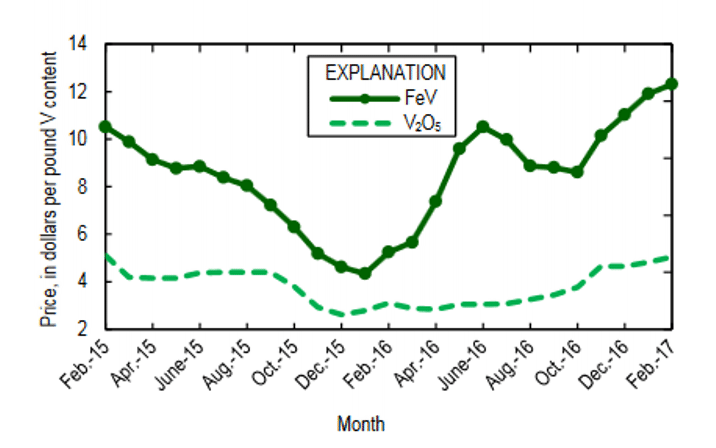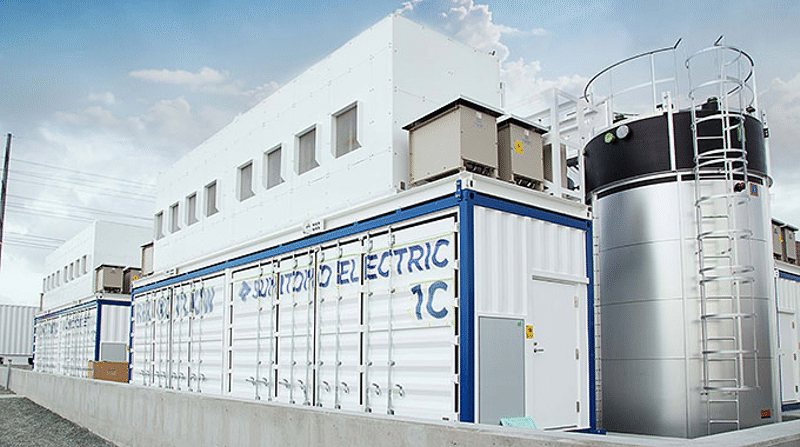Specialty Metals & Minerals: Vanadium
Vanadium’s fastest growing use is in vanadium redox batteries. This technology is almost certain to replace lithium ion batteries for fixed storage, although unlikely to compete in the electric vehicle market. The future demand growth for lithium, graphite and cobalt is therefore likely to be much more muted than the hype suggests. The investor in the battery storage space needs to understand vanadium.
Uses
Over 90% of vanadium is used in steel alloys and cast irons. Vanadium strengthens steel, which in turn allows less steel to be used. Two large uses are rebar and car bodies; in fact vanadium steel was first used in the Model T Ford. It also has ceramic and chemical uses, such as catalysts.
Only a very small amount of vanadium is currently used in vanadium redox batteries. However, these batteries are still at an early stage of development and growth is expected to be explosive. Compared with other batteries vanadium flow batteries are containerized, fully scaleable, nonflammable, have a minimum 20 year life, can discharge 100% of stored energy, and can retain charge for years.
The main future use is residential and grid scale storage. Particularly, storage of electricity generated by wind and solar, and to replace peak load generators. The image below is a 2MW/8MWh vanadium redox battery installed in California. It is planned to help integrate renewables into the grid and provide more flexible grid management. This is one serious battery.
Image Courtesy Sumitomo Electric
Production and Resources
World vanadium mine production in 2016 was estimated to be 76,000 tonnes, primarily from China, Russia and South Africa. However, the main source of vanadium is coproduction from steelmaking slag. Primary production from mines amounts to around 25% of supply and the balance at 10% is from secondary processing of petroleum residues and the like.
The United States Geological Survey estimates that world primary vanadium resources amount to around 60 million tonnes. It occurs in phosphate rock, titaniferous magnetite, uraniferous sandstone along with several other sources. Because vanadium is typically recovered as a coproduct or byproduct, which are not included in the above total, actual resources are no doubt much larger than 60 million tonnes.
The Market
Vanadium is typically traded as either vanadium pentoxide (V2O5) or ferrovanadium (Fe.V). The price for ferrovanadium varies dependent upon the vanadium content. For example, FeV75% would attract a higher price than FeV50%. Impurities such as silica, phosphorus and sulphur, also negatively impact the price of both vanadium pentoxide and ferrovanadium.
Sales are typically made direct to the end user, by either contract or spot sales. The chart below shows vanadium prices for the last two years. While there has been a strong recovery in the ferrovanadium price over the past year, it is still far below the 2008 high of over USD35/lb.
 Chart Courtesy USGS, based upon data from CRU Group
Chart Courtesy USGS, based upon data from CRU Group
The Australian Scene
The following table lists those Australian listed companies with vanadium being an important project for the company. There are other companies with exposure to vanadium but generally as a very minor part of the asset base.
| Name | ASX Code | MarketCap.(AUDM) | Project | Comments |
| Australian Vanadium Ltd | AVL | 21 | Gabanintha Vanadium/Uranium | Is agent for import of vanadium flow batteries |
| Energy Metals Ltd | EME | 23 | Bigrlyi Uranium/Vanadium | JV with NT Uranium & Southern Cross Exploration |
| Intermin Resources Ltd | IRC | 19 | Richmond Oil Shale Vanadium/Molybdenum | JV, AFX Resources Ltd can earn 75% |
| King River Copper Limited | KRC | 3 | Speewah Vanadium/Titanium | Metallurgical testwork underway |
| Neometals Ltd | NMT | 152 | Barrambie Vanadium/Titanium | Focus is on Titanium, various Lithium interests account for the marketCap. |
| TNG Ltd | TNG | 116 | Mt Peak Vanadium/Titanium/Iron | In development |
| Technology Metals Australia Limited | TMT | 5 | Extensions to AVL’s Gabanintha Project | Exploration, resource statement upcoming. |
Missing from the above list is the ill-fated Windimurra project. The project was first developed by a joint venture between Precious Metals Australia and Xstrata in the late 1990’s. The plant was closed in 2003 and dismantled by Xstrata. PMA regained control in 2005 but went into receivership before the rebuild was complete. Atlantic Ltd bought the project from the receiver and production recommenced in 2012. The plant never made money and then caught fire in 2014. And then Atlantic was off to administration. The project is now held by an unlisted Singapore company.
AVL
AVL is probably the most focused of the above vanadium stocks. While it does have cobalt and lithium interests, its prime focus is vanadium. The Gabanintha Vanadium Project, in Western Australia, hosts a resource of 91.4Mt at a decent grade of 0.82% V2O5, with cobalt as a potential byproduct. It has also commissioned a vanadium electrolyte pilot plant, with the intention of producing electrolyte suitable for use in vanadium redox batteries.
Of most interest to me is its involvement at the point of sale for vanadium redox batteries. AVL has an agreement to sell Gildemeister GmbH vanadium redox batteries in Australia. The company has already made its first residential sale, and the results are impressive, as shown in the chart below. The remarkably consistent fluctuation in charge level shows the daily discharge and solar recharge. AVL is worth watching.
EME
EME is effectively a uranium company. They have eight uranium projects in the Northern Territory and Western Australia. The company is controlled (66%) by China Uranium Development Company Ltd.
In the Northern Territory, the Bigrlyi (EME 53.3%) deposit hosts a significant amount of vanadium along with uranium. The total Bigrlyi resource is 7.46M tonnes at 0.12% uranium and 0.2% vanadium. However, uranium mining in Australia is highly politicised and any proposed development can expect a long and tortuous path to approval. Thus, EME’s vanadium is likely locked in for the foreseeable future.
IRC
IRC is primarily a small gold mining/exploration company. But it does have a large land holding in Queensland of vanadium and molybdenum rich oil shales, the Richmond vanadium-molybdenum project. The project hosts the Alison Resource, 2.9B tonnes at 0.39% V2O5 and 290g/t MoO3, and the Liliyvale Resource, 410M tonnes at 0.44% V2O5 and 332g/t MoO3..
The project has been recently farmed-out to AXF group, a property development group run by Richard Gu, a scion of one of China’s wealthiest families. The objective is to investigate the most appropriate method for extracting the vanadium and molybdenum from the shale. A longshot, but if it works it will be a market revolution.
KRC
This company is focused on the Speewah Vanadium Titanium project. This project host 4.7B tonnes at 0.3% vanadium and 2% titanium. The company is currently focused on a concept study designed to produce vanadium pentoxide and titanium dioxide. The objective is to identify a suitable hydrometallurgical treatment route to produce vanadium products suitable for use in vanadium flow batteries.
NMT
The vast bulk of the company’s market cap reflects its lithium interests. But it does hold the Barambie titanium vanadium project, 47Mt @ 22.2%Ti & 0.63%V. The company is developing the production of titanium hydrolysate (Ti(OH)4), V2O5 and Fe2O3 using the patented NEOMET hydrometallurgical process. It is seeking to commercialise the technology in joint venture with the owners of the technology.
MNT is primarily interested in the titanium but could become a meaningful vanadium producer.
TNG
TNG is looking to develop the Mount Peake vanadium-titanium-iron project in the Norther Territory. The project hosts a total resource of 160M tonnes at 0.28% vanadium, 5.3% titanium and 23% iron. A 2015 definitive feasibility study gave an NPV8 of AUD4.9B, capex of AUD970M, and a payback of 4 years.
The company’s aspirations are huge, with a plan to produce high value-added products for export. It proposes producing very high purity vanadium pentoxide and/or ferro-vanadium, high grade titanium dioxide and “high purity” iron oxide. The process to be used, the TIVAN® process, is new and untested, other than at pilot plant scale. This is a significant risk to the investor, however TNG has good management and once financing is in place there will be a substantial reduction in risk.
TMT
The company listed in December 2016 and completed its maiden drill program in the March 2017 quarter. The results were very consistent in terms of grade and width, as can be seen below. The company expects to release an initial resource estimate within the next month or so. Worth watching as its market cap is low given the potential size and grade of the resource they will define.
Image courtesy TMT
Conclusion
Vanadium demand [and hence price] is directly related to steel demand. This demand is unlikely to grow much in the short term.
But of more significance is the future of vanadium redox batteries. It appears to be the best battery for stationary storage and will continue to improve in cost and efficiency over the next few years. Widespread adoption of these batteries will significantly increase the demand for vanadium. This is a sector worth watching.



